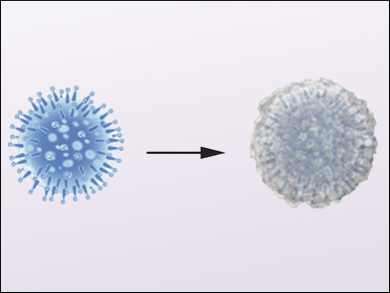Avian Flu
Avian flu can be transmitted from birds to humans; transmission among humans, however, is limited. The reason may be an eggshell-like mineral layer that the virus acquires due to the high calcium concentration in the intestines of birds. As reported by Chinese researchers in the journal Angewandte Chemie, these mineralized viruses are significantly more infectious and, in addition, more robust and heat stable than the native viruses.
Avian flu is a highly infectious disease among birds that has developed into a serious threat to human health. Close contact with diseased birds or their feces is considered to be the primary source of infections in humans. Transmission between humans is limited, however, which indicates that these viruses cannot directly infect humans. Previously it was assumed that these viruses crossed the species barrier as a result of mutation or recombination with another pathogen. More recent results demonstrate that avian flu viruses isolated from infected humans have the same gene sequences as those from birds.
Mineral Shell around the Virus
So how is it that humans catch the disease from birds? Researchers working with Ruikang Tang at Zhejiang University (Hangzhou, China) claim that it is because the viruses acquire a mineral “shell” in the bird intestines. They discovered that viruses can become mineralized under calcium-rich conditions. Naturally, the digestive tract of birds—the primary location of avian flu viruses—provides just such a calcium-rich environment, so that the birds can make egg shells.
Experiments with a solution that imitates the bird intestine environment allowed the researchers to demonstrate that 5 to 6 nm shells of a calcium phosphate mineral form around H9N2 and H1N1 viruses. In both cell cultures and in mice, these mineralized viruses proved to be significantly more infectious—and deadly—than the native viruses. In humans, avian flu viruses infect the airways and are then found in bodily fluids, where the calcium concentration is too low for mineralization.
Explaining Human Infections
The mineralized shell changes the electric surface potential of the viruses. This causes mineralized viruses to adsorb much more efficiently onto the surfaces of future host cells. The mechanism for uptake into the host is also different. Normally, the virus docks at receptors on the cell surface and is then brought into the cell. The mineral layer inhibits this—but clearly stimulates very efficient uptake on its own. Within the cell, the mineralized viruses enter into lysosomes, whose slightly acidic environment dissolves the mineral shell and releases the viruses.
This new information explains why humans are more likely to catch avian flu from birds than from their fellow humans, and may help in the development of new approaches to battling avian flu.
- Mineralized State of the Avian Influenza Virus in the Environment,
Hangyu Zhou, Guangchuan Wang, Xiaoyu Wang, Zhiyong Song, Ruikang Tang,
Angew. Chem. Int. Ed. 2017.
DOI: 10.1002/anie.201705769




